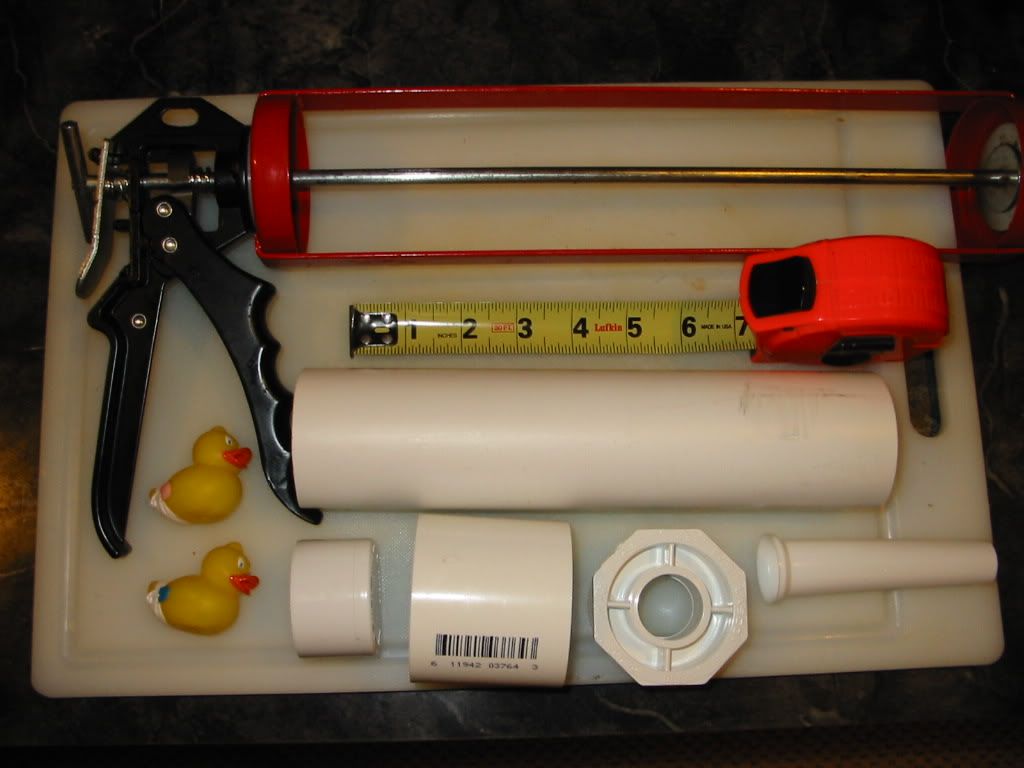Thanks to a recent NASA (
National Association of Sausage Associations) development, you... yes, YOU! ...can now have your very own "Russ-n-Ross Ram-Rod" Small Batch Sausage Stuffer, version 2, for a mere pittance. Yes, folks, they never found WMDs in Iraq, and you'll never find them in any store, but if you call now, you can assemble your very own
Widget for
Meat
Distribution for only $25 or so. Operators are standing by...
 Navel Research Laboratory photo, showing grandchildren for size comparison.
Navel Research Laboratory photo, showing grandchildren for size comparison.
As you surely recall, Ross and I exchanged a series of exchanges (well... whatever they`re called) about better ways to stuff sausage, particularly when the amount to stuff is small. My old horn-style Sears Special 5 Lb. stuffer has about a 2 lb heel left when the plunger bottoms out. Try that on a 2 lb batch of sausage and you don`t get very far. So, Ross built himself a device from PVC pipe and machined wood and O rings and screw thread. ...a beauty! The problem is, Ross is a machinist and I`m not. (The other problem is, I`m too cheap to hire a machinist, but we won't go there.) So... what to do?
Inspired by Ross's most recent post, I hit the hardware store. My earlier efforts at building an all-PVC version had met with mixed success. I couldn`t exert enough force on a 2" diameter tube of sausage to force it through the stuffer tube and into the casing. The thing also required about five hands in order to hold everything. Heartened by Ross`s success with a threaded screw plunger but tempered by my failure with brute force, I decided to reduce the diameter to 1-1/2 inch PVC, which would fit into a mechanical caulking gun in place of the caulk. Fortified by a couple of sausage biscuits, I headed for the hardware store on a bright Saturday morning, determined to find the right parts.
The first thing I found was that I could discard the 1-1/2" idea. A larger "Liquid Nails" caulking gun was available. The 2" pipe I had been using fit into it with room to spare. I already had purchased a 2" ID to 1" OD reducer, and a female/female coupling fitting. By buying a slightly smaller washer to replace the one on the caulking gun (so it would fit up inside the 2" pipe), plus a 1-1/2" pipe cap, I was good to go. The clearance between the cap and the inside diameter of the 2" pipe is fairly close. Each of my existing stuffer tubes fit down into the reducer. With sausage meat in the pipe, compression forces hold both the stuffer tube and the cap in place.
As it turned out, I can lay the whole thing on its side, manipulating the casing with left hand and squeezing the handle on the caulking gun with the right (or vice versa). The only trick is to remember to put the stuffer tube through the end of the caulking gun before threading the hog casing onto it. This could be remedied by enlarging the hole in the end of the caulking gun, but as I said, I`m no machinist.
Did it help? Well, I only had about 2-1/2 ounces of sausage meat left over when finished, the majority of it left in the stuffer tube. It was just right for a well-earned little snack. Cleanup is literally a snap- - PVC pipe is designed for potable water service, snaps apart for cleaning (no need to glue it together), and cleans up with just soap and water. Contrast that with my nasty old hard-to-clean cast iron horn stuffer, which takes a half hour to disassemble and wash, dry and lubricate and put away.
Next...??? I may cut two additional lengths of 2" pipe so I can load everything and go. My first run, which was a nominal 2 lb. batch of Greek Loukanikos, I had to pull the 2" pipe only once to reload. For up to, say, 5 lbs, I should pre-load three lengths of pipe and stuff a single length of casing. Then, for each other couple of pounds, I`ll fit another "short" of casing, refill the three pipe segments, and go again.



